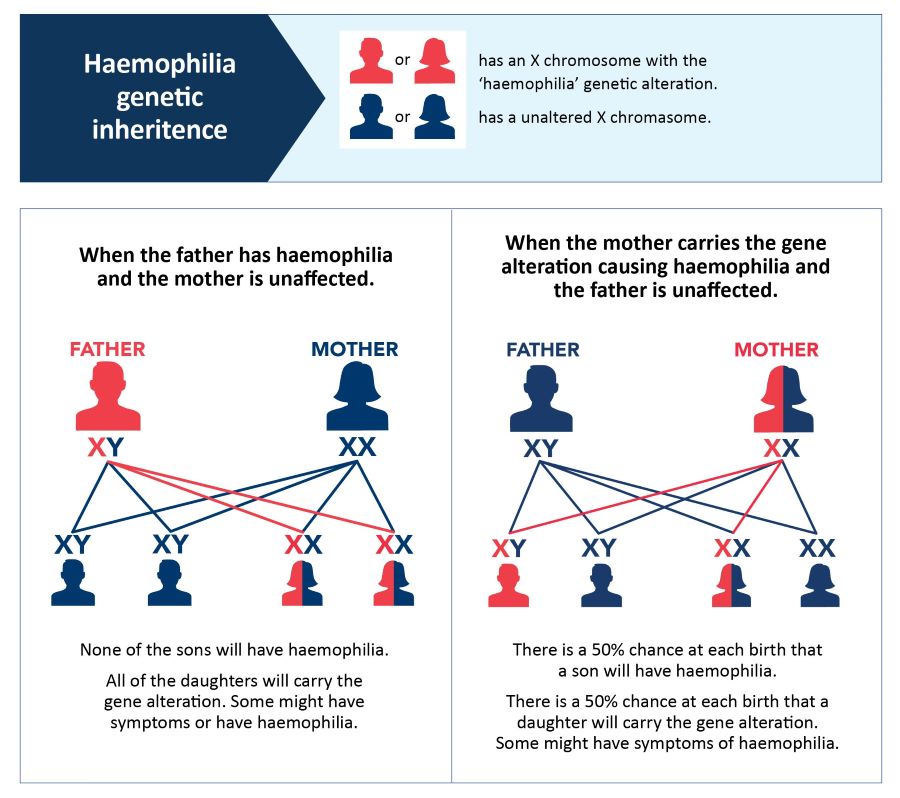What is a carrier?
In genetics all females who have the gene alteration for haemophilia are described as haemophilia carriers, because they ‘carry’ the gene alteration.
Another important step in diagnosis is to draw a family tree to identify any other family members with haemophilia or who are haemophilia carriers.
Haemophilia and inheritance
Haemophilia occurs when you have a mutation or alteration in the gene that makes clotting factor VIII (8) or factor IX (9). The gene alteration is inherited and passed down the generations from parent to child.
This means that haemophilia ‘runs’ in families.
No family history?
About one third of all cases of haemophilia appear in families with no previous history of the disorder. This happens when a new alteration in the F8 or F9 gene occurs by chance in an egg cell or sperm cell. The child who is conceived will have haemophilia or be a carrier and can pass the gene alteration on to their children.
Sometimes this gene alteration has occurred a generation or two earlier and the family has not known about it until they are tested.
Testing the family
If someone is diagnosed with haemophilia or as being a haemophilia carrier, it is likely that other members of their family may also have haemophilia or may be a carrier. To find out other male and female family members may also need to be tested for haemophilia.
Clotting factor genes and families
If you are thinking about genetic testing, it can be helpful to understand how haemophilia is passed on in families.
The pattern of inheritance depends on whether a person is male or female. This is because the clotting factor gene is located on a sex chromosome.
Sex chromosomes and haemophilia
Chromosomes are packages in our cells that contain our genes. They decide our individual characteristics, such as the colour of our hair or our eyes. Sex chromosomes are different in males and females. They determine which biological sex we are. They also determine how blood clotting works in our body.
Each parent contributes one of these sex chromosomes to their children:
- Females have two copies of the X chromosome, and receive one from each parent
- Males have one X chromosome, which they receive from their mother, and one Y chromosome, which they receive from their father.
Haemophilia
The genes for making factor VIII (8) and IX (9) are located on the X chromosome.
Inheritance
Any male or female with an alteration in their F8 or F9 gene can pass it on to their children.
If you are a female who is a haemophilia carrier, there is a 50% chance with each of your pregnancies that you will pass the gene alteration onto your baby:
- If you have a son who inherits the gene alteration, he will have haemophilia.
- If you have a daughter who inherits the gene alteration, she will be a haemophilia carrier too and may have haemophilia.
If you are a male with haemophilia:
- All (100%) of your daughters will inherit the gene alteration from you. They will be haemophilia carriers and some may have haemophilia
- None of your sons will inherit the gene alteration from you. They will not have haemophilia and will not be able to pass it on to their children.
Inheritance pattern in haemophilia

Obligate carriers
Sometimes your inheritance pattern means you must have the gene alteration. In genetics this is called being an obligate carrier.
Obligate haemophilia carriers include:
- ALL daughters of a man with haemophilia
- Mothers of one child with haemophilia, and who have at least one other family member with haemophilia
- Mothers of one child with haemophilia, and who have a family member who is a haemophilia carrier
- Mothers of two or more children with haemophilia.
